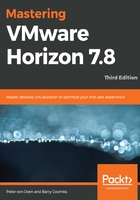
The history of VMware and VDI
The concept of virtualizing Windows desktops has been around since as early as 2002 when VMware customers started virtualizing desktop operating systems and hosting them on servers running the ESXi hypervisor from the data center. At that time, there was no concept of a connection broker, and the phrase VDI was never commonly used. End users simply connected, using the RDP protocol, directly to a dedicated desktop virtual machine running Windows XP. This was the same as how you would manage a server remotely, that is, by making an RDP connection directly to the desktop of the server. From there, the journey began. The following timeline highlights the key milestones of that journey:
- 2005: VMware demonstrated the concept of a connection broker.
- 2006: VMware launched the VDI alliances program.
- 2007: A prototype connection broker was introduced to customers, before being released as a product called Virtual Desktop Manager (VDM) version 1.0. VMware acquired Propero for $25 million.
- 2008: VDM 2.0 was released in January 2008. VMware View 3.0 released and Citrix entered the VDI market, releasing XenDesktop 2.0.
- 2009: VMware View 4.0 released—the first version with PCoIP.
- 2010: VMware View 4.5 was released with new features such as local mode (offline desktops), PCoIP enhancements, Windows 7 support, and the ability to tier storage. This was also the year that VMware talked publicly about the biggest VDI reference case to date with Bank of Tokyo Mitsubishi, who deployed 50,000 virtual desktop machines.
- 2011: VMware view 4.6 released with the iPad client, and the PCoIP Secure Gateway function for the View Security Server, which allows users to connect to their virtual desktop without needing a VPN connection. View 5.0 released with the introduction of Persona Management. View 5.0 also introduced 3D graphics support by using the latest vSphere 5.0 platform, as well as some major enhancements to the PCoIP protocol.
- 2012: View 5.1 released with View Storage Accelerator, View Composer Array Integration, the ability to scale the hosting infrastructure up to a 32-node cluster when using NFS storage, radius two-factor authentication, improved USB device support, a standalone View Composer, and the ability to support profile migration from XP to Windows 7, as well as from physical desktops to virtual desktops, with Persona Management.
- 2013: View 5.2 released, and to bring it in line with VMware's launch of the new Horizon brand (launched at the same time), it was renamed Horizon View 5.2. This included support for unified comms with Microsoft Lync 2013, hardware-accelerated graphics with Virtual Shared Graphics Acceleration (vSGA), Windows 8 support, and a feature pack that allowed a user to access their desktop in an HTML5 browser using the VMware Blast protocol. View 5.3 introduced Virtual Dedicated Graphics Acceleration (vDGA), which allowed a virtual desktop to have dedicated access to a GPU that was installed on the host server. Support for Windows Server 2008 R2 was added to the virtual desktop machine to get around the fact there is no Service Provider License Agreement (SPLA) for Windows 7.
- 2014: This was the final 5.x release with Horizon View 5.3.1, which added support for Virtual SAN (VSAN). Horizon 6.0 was released, adding View-hosted apps, and was the first time that VMware supported hosted apps and desktops using RDS. View 6.0 also introduced the Cloud Pod Architecture, and the ability to span the View infrastructure across multiple data centers for DR and scalability. Removal of View Local Mode was also included. In the 6.0.1 release, USB 3.0 support was added, as well as extended printing, HTML access for Windows 8.x, and system tray redirection for hosted applications. This was followed by the 6.0.2 release, which included a new feature pack that added new versions of the View Agent, HTML access, MMR redirection, and scanner redirection.
- 2015: View 6.1 was released with support for NVIDIA GRID vGPU. It also added support for IPV6, Virtual SAN 6.0, Virtual Volumes, and Windows Server 2012 R2 running as the virtual desktop operating system. 6.1.1 then launched, adding features such as client drive redirection, support for Linux desktops, MMR for RDS desktops, and HTML support for accessing hosted apps. Horizon 6.2 added support for Windows 10 desktops, Access Point integration, AMD vDGA, 4K monitors, and Virtual SAN 6.1, along with several enhancements to the Cloud Pod Architecture, admin console, and Linux desktops. A maintenance release was included 6.2.1 in December 2015, and 6.2.2 in February 2016.
To summarize, this timeline is shown pictorially in the following diagram:

That brings us right up to date and to the latest version of Horizon, VMware Horizon 7.